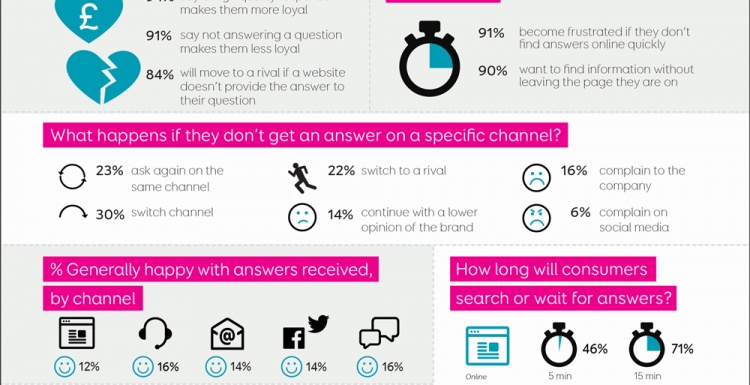Expectations and buying behaviors of today's modern consumers
Study uncovers the habits of highly active shoppers on the streets of New York, Chicago and Los Angeles

What are the expectations and most influential touchpoints for today's omni-channel shopper? These are the questions retail technology leader Aptos, Inc. set out to answer in its new research study, "Inside the Mind of the Modern Shopper."
Looking to understand today's modern shopper expectations and buying behaviors, the research study polled more than 300 shoppers (aged 18 to 55) in 3 of the largest retail markets in the U.S. - New York, Chicago and Los Angeles - in one-on-one "Shopper on the Street" interviews. Visit www.aptos.com to download the full survey report.
The study findings indicate that the store is still very relevant to shoppers. In the study, the store was named the predominant channel for purchasing; 57% of shoppers surveyed indicated they made their last discretionary purchase inside a store, whereas 39% said their last purchase was made via an eCommerce site. Respondents consistently indicated they valued interaction with knowledgeable store associates and the ability to try products before buying as the key factors that keep them coming back to the store.
However, while the store remains the dominant channel for purchasing, shoppers consistently rely on other channels to accomplish a variety of tasks during their shopping journeys. While 32% of shoppers said they used retailers' web sites to research their most recent purchases, a full 22% used Amazon.com -- even though Amazon was not the site where the purchase was made.
Further, the research revealed that aside from retailers' web sites, Amazon has become the dominant source for product research and inspiration for consumers. In fact, more of the Shopper on the Street surveyed use Amazon for research and inspiration than Facebook, Pinterest, Twitter, Instagram and blogs combined.
Also of note, the top channels for product reviews and product evaluation were mobile sites and mobile apps; 40% of respondents indicated they accessed product reviews and information regarding products, colors and sizes using mobile sites and apps. This preference could indicate shoppers' desire to access information on mobile devices to support decision making while browsing store aisles -- consistent with the rise of showrooming and webrooming trends in recent years. The most popular channel for deals and coupons was email, cited by 82% of shoppers.
While price, promotions and deals continue to be the dominant influences on purchase decisions, shoppers indicated that shipping, delivery and pickup flexibility were also key considerations. In fact, shoppers had a wide and healthy appetite for various forms of fulfillment. Of those polled, 46% said the most important delivery/fulfillment option was "ship to neighborhood locker locations," while 23% cited "shop in-store, ship to home." Underscoring the importance of responsiveness, 34% cited "same day delivery," while shop online pick up in store was cited by 24% of respondents.
Consistently great service across channels was viewed as a priority for many shoppers. In fact, it was a top three influencer for 34% of all shoppers. "Shoppers expect to transition fluidly across touchpoints, and they will no longer tolerate inaccuracies, inconsistencies, confusion or delays," said Dave Bruno, marketing director for Aptos.
Geographic Differences in Shopper Behavior
Along the way, researchers identified some interesting nuances in channel behaviors between shoppers on the West Coast, East Coast and in the Midwest.
Of those shoppers surveyed, Los Angeles shoppers had the highest proclivity to purchase in store (88%) versus shoppers in Chicago (85%) and New York (83%). Results could be somewhat influenced by weather considerations; however shoppers were asked to identify their typical shopping behaviors.
The store was also shown to be the top choice of shoppers for research across all geographies. Greater usage of physical retail stores for research purposes was shown by Chicagoans (77%) and New Yorkers (74%) versus Los Angelenos (58%). One contributing factor could be the greater proximity of stores to and from work commutes considering both Chicago and New York have a larger concentration of commuters leveraging public transportation.
Los Angeles also had the highest ratio of Facebook and Instagram viewing among shoppers polled. This could be due to the fact that Los Angeles County residents (median age 34) tend to be slightly younger than residents in Cook County, Chicago (median age 35) and in New York County (median age 36).1
"It's vital for brands to get to know the 'Shopper on the Street' -- to understand their needs and refine engagement strategies as consumers embrace new touchpoints and technologies," said Bruno. "In today's fast-moving omni-channel retail world, retailers have more ways than ever to serve customers but also a tremendous challenge in ensuring all parts of the retail enterprise are integrated and aligned. The only way to deliver seamless experiences that meet each shopper's needs is unified channels and interactions that enable retailers to expand and enhance shopper functionality, to manage inventory and orders consistently across the retail enterprise, and to recognize and respond to each shopper anywhere on their paths to purchase with informed, personalized support."
















